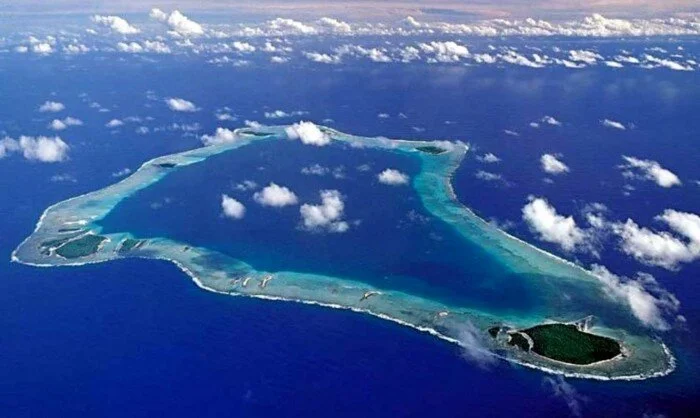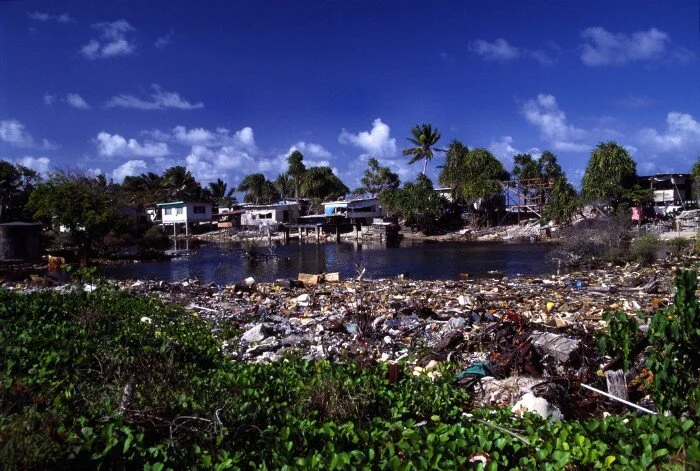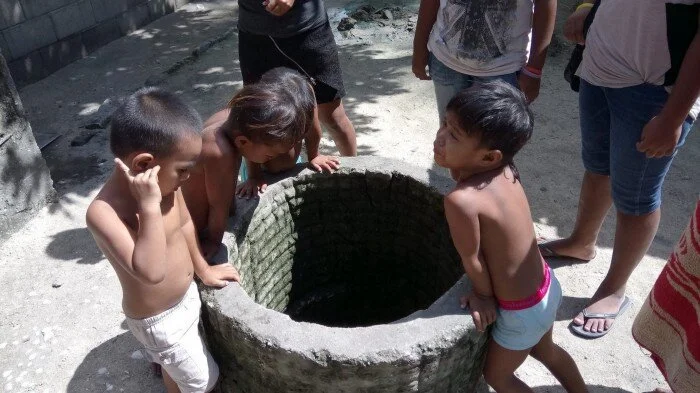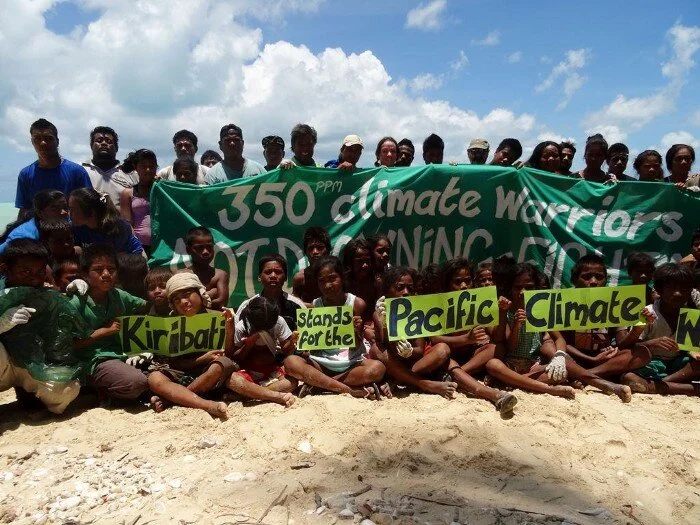Current Event Series #4— David Fyfe’s Lecture on Climate Change and South Pacific Atoll Countries
Less than two months ago, the United States suffered one of the most devastating and costly hurricanes, Hurricane Harvey and Hurricane Irma. We, as a nation, witnessed people rescued by local do-gooders, shuttling people onto boats, pick-up trucks, even jet skis. It’s hard to imagine a future in which such devastation and aftermath will accompany our lives again. Hurricane Harvey and Irma ended up costing about $150 — $200 billion and leaving a combined 211 fatalities — and that is only from the United States and its surrounding islands.
South Pacific Atoll Country/Photo credit: brizzle born and bred via Visual Hunt / CC BY-ND
The ignored part of the world, in light of global warming is the ocean, specifically, the South Pacific. We forget there are countries with thousands of people who live out in the middle of the ocean, a long way from Texas, Florida, and everywhere else in the world.
On October 18, 2017, David Fyfe, an associate professor of geography at York College of Pennsylvania, gave a lecture on “Climate Change and Atoll Countries in the South Pacific.” Dr. Fyfe is also a researcher, whose interests include Geographic Information Systems (GIS), cultural and environmental field studies, and geographic perspective on sustainability. His research interests led him to the Pacific Islands, Kiribati and Tuvalu, both atoll countries found near the Fiji Islands in the South Pacific. Fyfe presented his findings, observations, and experiences obtained in his recent sabbatical over the last few months, as he lived amongst the islanders in the South Pacific.
His research focused on collecting data on the extent of flooding, impact on critical infrastructure and on the local community, and a better understanding of rising sea levels in the Pacific Region. For reference, an “atoll” country is a ring-shaped island formed around a volcano. As the volcano becomes dormant and erodes into the sea, the ring-shaped coral-composed island remains. There are thousands of islands that make up an atoll country, and each island inhabits hundreds of communities.
After flying into the Fiji Islands, his first stop was to the country of Tuvalu, on its’ main island of Funafuti. Upon arriving, he soon learned he was the first American to ever visit the island. Dr. Fyfe stayed in Funafuti for one week, and during this time, he visited the governmental agency hoping to find the data on rising sea levels. The agency is home to the Te Kaniva, the Tuvaluan Climate Change Policy, focusing on future plans for the slowly sinking island. The officials that met with him admitted to have limited data pertaining to rising sea and elevation levels Dr. Fyfe came for. The official he met with informed him that the lack of data is due to an impossibility to fund the human and technological resources necessary to do so. They rely on people like researchers and non-profits to come to this country and bring with them such resources. However, he later found out the highest level — documented at 4 meter — was much lower than expected. Because of limited geographical documentation of infrastructure, schools, and homes, it is possible that a lot of these structures are built upon levels closer to sea level. This makes Tuvalu vulnerable to the devastation that awaits them as storms such as Harvey and Irma find their way to these atoll countries.
Max-filled dumpsite on Kiribati/Photo credit: mrlins via Visual Hunt / CC BY
Tuvalu and Kiribati and other atoll countries began suffering the consequences of climate change long before the developed world witnessed any of its effects. Because of this, these countries have become dependent on foreign aid and resources. Upon leaving the airport, Dr. Fyfe noticed how cargo containers littered the streets of this small island. Containers lay piled and vandalized — lining the streets of Tuvalu. It was where their food came from — nearly all of the resources found in the sole grocery store, hospital, and schoolhouse comes from outside support. In exchange for resources, foreign NGOs demanded fishing rights. As you can imagine, fish was the economic engine that provided Tuvalu with a means of self-reliance and capital. As the major fishing companies took over these waters, it became difficult for islanders to fish, as big-name fishing companies were absorbing most of the resources. Islanders, who once were able to walk a few feet out to sea to find fish, now have to go out several miles to find anything. Those who tried either came back empty-handed or didn’t come back at all, as the violent waters of the Pacific have claimed so many lives. With a diminishing supply of fresh food available, from various longitudinal studies done, it was found that nearly 80% of the population are considered obese. Of this 80%, 40% are under the age of 29, leaving the possibility of a life cut short due to diabetes and heart diseases.
Pacific Islanders also face a serious issue of available and usable space, particularly for their dead. Every cemetery is full and the only way to bury their dead is on property they own. Every house have at least 3–4 grave sites swarming the property. Space is also an issue for waste disposal, as most dumpsites are reaching max fill, and with the supporting countries, such as the U.S. and France, efforts are in place to advance the methods for sending waste out into the far sea to accommodate the growing need for space. Because of the polluted water harboring within the country’s lagoon, mostly at times of high tide, the already-established water collection systems, illustrated below, are bombarded with waste. The U.S. and Australia provide rainwater containers to accommodate the need for clean drinking water and nearly every household owns such a container.
Contaminated well in Kiribati/Photo credit: TGN1 via Visual hunt / CC BY-NC-ND
In light of satisfying his research goals, Dr. Fyfe sought to understand what the future of these countries would entail and the plans these countries are in the process of setting forth. He concluded that their main goal is to maintain sovereignty, raise money for future generations to migrate, raise awareness, and promote funding to maintain life for the thousands of people inhabiting these countries.
France is giving such atoll countries permission to migrate to several French Polynesian islands controlled by the French Republic. Kiribati and Tuvalu are only two of the hundreds of countries in the same situation, including Maldives, consisting of about 1,000 islands — Bangladesh, Palau, and many more. The focus for these atoll countries, like Kiribati and Tuvalu, is to migrate to nearby islands with the hope of continuing their community as they begin a new chapter of life together.
In 2003, Saufatu Sopoanga, Prime Minister of Tuvalu, told the United Nations General Assembly: “We live in constant fear of the adverse impacts of climate change. For a coral atoll nation, sea level rise and more severe weather events loom as a growing threat to our entire population. The threat is real and serious, and is of no difference to a slow and insidious form of terrorism against us.”
Photo credit: 350.org via Visualhunt / CC BY-NC-SA
Individuals like David Fyfe should inspire us to weigh in on the responsibility we have to these countries and, in any way we can, to provide our support. No matter how small it may seem to make changes to our everyday life to support the cause, it is all these islanders expect of us. The Tuvaluan Prime Minister reported that, in about 60 years, these countries won’t exist and the take away here is to take responsibility, do our part, and when the time comes, open our doors and hearts to the thousands of refugees whose homes were washed away due to climate change.
Works Cited
Astaiza, Randy. “11 Islands That Will Vanish When Sea Levels Rise.” Business Insider, Business Insider, 12 Oct. 2012, www.businessinsider.com/islands-threatened-by-climate-change-2012-10/#nt-believe-us-that-climate-change-is-real-12.
Fyfe, David. “Climate Change and Atoll Countries in the South Pacific.” York College of Pennsylvania, 18 Oct. 2017, Weinstock Lecture Hall, York, PA.




